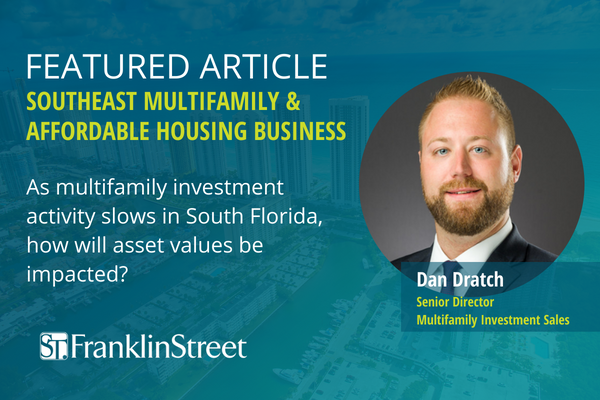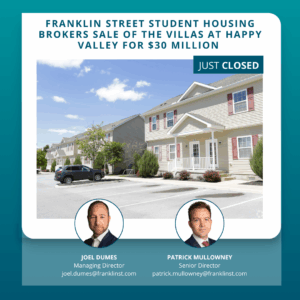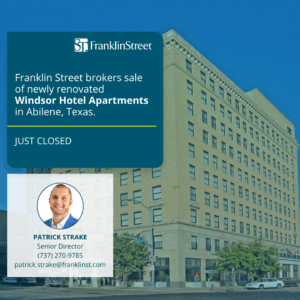Franklin Street’s Dan Dratch, Senior Director of Multifamily Investment Sales, was recently interview by Southeast Multifamily and Affordable Housing Business on the outlook for South Florida’s multifamily market in 2023. Below, are highlights from the interview:
South Florida’s multifamily investors know a storm is coming. But threats of disaster, natural or economic, seem incapable of toppling confidence in this region’s potential.
The optimism is born out of sustained population and job growth paired with residents’ desires — in many cases their needs — to live in apartments instead of buying homes.
Jobwise, Florida is also faring well, a fact some investors point out as a key difference between the Great Recession of 2007 to 2009 and the recession most economists agree will hit the United States later this year.
INVESTMENT SALES ACTIVITY DROPS
The market may be tough on renters, but relatively high yields and asset performance continue to entice investors. Even so, like all markets around the country, transaction frequency is cooling off in South Florida. According to Franklin Street Senior Director Dan Dratch, multifamily sales dipped sharply at the end of the year. He reports that South Florida investors completed 64 transactions totaling $1.4 billion during the fourth quarter of 2022, compared with 227 transactions totaling$7.4 billion in the fourth quarter of 2021.
“The fourth quarter of 2021 was by far the highest transaction volume we’ve seen down here in South Florida,” says Dratch.
“Combine the number of transactions with rental increases and the lowest interest rates we’ve seen in some time and what resulted was a craze for purchasing apartments that fueled a post-COVID ramp up of valuations. I don’t want to use the word ‘overpay,’ but valuations got super inflated in 2021.”
Coming down from 2021’s buying frenzy and double-digit rent-growth figures, the logical conclusion might be that asset values have decreased. However, Dratch says that a lower number of transactions does not mean properties are worth less today. He explains that the price per unit and price per square foot are the best indicators for measuring the market’s
health overall. In the fourth quarter of 2021, the average price per unit in South Florida was $289,519, up from $215,417 per unit in the second quarter of 2020.
In the fourth quarter of 2022, the price per unit was $307,089, according to Franklin Street. “Historically, we are still at some of the highest price-per-unit numbers we’ve ever seen,” says Dratch. “That means if we can get to a place where the number of transactions starts to pick back up, then the buildings are still worth more today than they were coming out of
COVID.”
MARKETS BEYOND MIAMI HOLD STEADY
Investors and developers express optimism about other South Florida metros, while conceding that buyers and sellers are more bearish than they were in 2021.
…
Insurance is a concern for Florida owners and investors, especially following the Surfside condo collapse that occurred on June 24, 2021, and Hurricane Ian, a Category 4 storm that made landfall in Florida on Sept. 28, 2022. “Most multifamily owners in South Florida have seen their insurance costs increase by 20 to 30 percent in the past year,” according to a spokesperson for Franklin Street’s insurance team. “However, some have started to see increases of more than 100 percent.” By comparison, the rest of the nation has seen costs of equivalent policies rise about 10 to 20 percent.
In response to spiraling insurance costs and a rash of insolvencies and losses among carriers that were magnified by Hurricane Ian, Gov. Ron DeSantis signed Senate Bill 2A into law to stabilize the property insurance market. The law establishes the Florida Operational Reinsurance Assistance Program (FORA), which is a $1 billion fund to back up insurance companies in the event of a natural disaster. The program authorizes eligible insurers to purchase reinsurance coverage under FORA.
“Market conditions explain the huge drop-off in sales between 2021 and 2022,” says Dratch. “But in Florida we also had historically high insurance costs. Although we dodged damage from Hurricane Ian in Southeast Florida, it has affected the entire state, and that is causing insurance carriers to change their tune. Insurance is almost as big of a problem as the affordability of interest rates. Cutting corners is not going to work for landlords. The advice we give owners is simple: Treat your buildings like you’re going to own them forever.”
Read more here from Southeast Multifamily & Affordable Housing Business.




